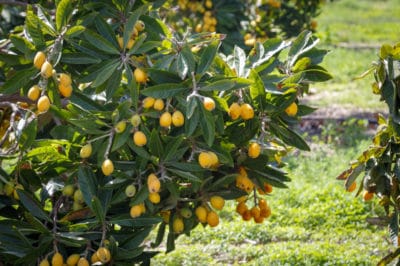What “Growth Rate” Means
A loquat tree’s growth rate measures the increase in its height over a one-year period. Both its growth rate and the increase in its overall size depend on a number of factors. The three official growth rate designations are:
- Slow: Plants that grow up to 12 inches per year
- Medium: Plants that grow 13 to 24 inches per year
- Fast: Plants that grow 25 or more inches per year
When planted from seed, loquat trees generally fall into the slow-growing category, growing just 6 to 12 inches per year and needing from seven to nine years to begin fruiting.
If you’re really eager for fruit, a grafted, one-year-old tree is a much better choice. In the right conditions, it will grow 1 to 2 feet annually and yield fruit in two to three years.
Boosting the Growth Rate
To help your loquat tree achieve a 2-foot annual growth rate, take the following steps.
Adjust for Your Climate
Loquat trees grow in USDA plant hardiness zones 8 through 10 but fruit reliably only where winter lows remain above 27°F (-2.8°C). And temperatures frequently topping 95°F (35°C) can slow their growth rate, especially when paired with drying winds.
In Florida, Texas or another hot-summer area, plant your loquat in a wind-sheltered spot with afternoon shade.
Prepare Your Planting Site
If your loquat competes with other plants for soil nutrients and moisture, its growth rate will suffer. Uproot all the vegetation within a 3-foot circle of your planned planting hole. Then maintain the cleared zone with a 3- to-4 inch layer of organic mulch. Wood chips or shredded leaves are good choices.
Expert gardener’s tip: Keep the mulch at least 2 inches way from the tree, so moisture doesn’t accumulate on the bark.
Give the Roots Some Help
The roots of nursery-raised loquat trees grown in soilless medium struggle to penetrate garden soil. Unless you remove enough of the medium to expose the top and sides of the root ball before planting, the growth rate will be very slow.
Finesse Your Fertilizing
Fertilizing a loquat can be tricky. Too much nitrogen fertilizer stimulates its wood production at the expense of flowers and fruit. A safer bet is to use an organic, 0-10-10 fish emulsion. It has no nitrogen, but plenty of root-building phosphorous and potassium.
Your newly planted tree will develop a dense root system that gets stronger with each application. That translates to vigorous, all-around growth of its wood, flowers and fruit.
